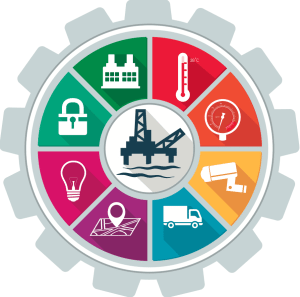 [Via Satellite 11-09-2015] Hardware and software manufacturers, alongside satellite communication service providers, are on their way to presenting offshore rig operators with always-on communications through a range of more flexible technologies. The issue particularly impacts energy companies that operate at sea and move frequently, and are struggling ways to advance and leverage communications technology in a transient environment.
[Via Satellite 11-09-2015] Hardware and software manufacturers, alongside satellite communication service providers, are on their way to presenting offshore rig operators with always-on communications through a range of more flexible technologies. The issue particularly impacts energy companies that operate at sea and move frequently, and are struggling ways to advance and leverage communications technology in a transient environment.
In the panel "How to Advance Communications in Transient Environments" speakers from Harris CapRock, Rice Electronics, and Transcendent Global Networks discussed how new satellite communication technology, alongside hardware that can harness the Internet of Things (IoT) and novel messaging protocols that can effectively handle increasing volumes of data, are working to make this possible.
"Geographic mobility is a very important aspect to providing the freedom to the customers to allow a rig to relocate from one location to another. Our customers don't necessarily know where the next job is, they can't plan for where the rig is going, so they cannot predict what is required and the service company doesn't exactly know what it needs when it gets there, so there is a very reactive model," explained Andy Lucas, chief technical officer at Harris CapRock.
To accommodate customers in transient environments, the company has developed a solution called Harris CapRock One, a communication service that monitors for and adopts the best-fit satellite, wireless or terrestrial network as the rig or ship is in transit.
"It allows the customer to freely roam wherever they want worldwide and the equipment self configures to the most appropriate configuration in the given conditions," said Lucas. The company's multi-band antenna is capable of supporting C-, Ku- and Ka-band and is remotely configurable, saving on the costs associated with an on-site service technician.
"It's also not just about geographic location, it's about the operations on the rig itself. So mobility, in our context, isn't just geographic mobility, it's about the ability for the installation to turn when an obstruction may come into play," said Lucas, citing both physical obstructions and those created by the weather, which could wash out Ku-band connectivity, for example. In situations such as this, the system can re-establish communications through another satellite without user intervention.
This type of reliability opens a window to what customers can achieve through communications technology and connectivity, allowing them to derive benefits from growing concepts such as the IoT. Enhanced satellite communications reliability in transient environments can also help companies and systems communicate more effectively.
Greg Berlocher, president of Transcendent Global Networks, is working to bring MQTT into the fold, a lightweight messaging protocol for use on top of the TCP/IP protocol that is designed for connections with remote locations where a small code footprint is required or the network bandwidth is limited. This blends Information Technology (IT) and Operations Technology (OT) to make the protocol ideal for the emerging Machine-to-Machine (M2M) or IoT world of connected devices, and for mobile applications where bandwidth and battery power are at a premium.
Through this, IoT can, among other things, help companies fill the knowledge and skill gap emerging during the great shift change as a younger and less knowledgeable workforce is rapidly replacing older, skilled workers.
"IoT is connecting people, places, process, and things where things were unconnected before. Now as IT and OT are starting to converge, organizations are beginning to ask for a way to scale for success," explained Jason Celaya, vice president of IoT for Rice Electronics, a company that provides communication, video and navigation equipment for the marine and oilfield industries.
"If anything, the economic conditions of today have accelerated that push, so companies have begun to look at business analytics, policies, data management, M2M, rather than pushing everything up to the cloud, to manage locations both off the grid, where they need satellite communication networks, and in metropolitan areas. They need global connectivity everywhere," Celaya added.
This pertains to both devices and people that are constantly travelling and therefore require constant, global connectivity. And the more connected these devices and people get, the more data companies can gather, fostering the age of big data and analytics, which can help companies save on man power and also improve safety by keeping workers out of dangerous environments or alerting them to what kind of environment they are walking into.
"With big data analytics, prior to even walking in to a facility they can see what's going on," said Celaya. "But not everything can be cookie cutter. You can't have the same air-gap technology everywhere. Just like when we go into a new situation ourselves, you have to analyze what is available, what is cost effective, and what we can deploy out there that can solve our issues. We have to look out to see how we can deploy the right communication solution for each environment."
Going forward, more solutions will no doubt emerge as reliable communications take hold in unstable and remote rig environments.
"The importance of being agile and adaptable is that it allows some of the absolutely now physical value products and services to be trusted in that remote, harsh environment. Being trusted allows customers to think differently about how IT is deployed and how efficiencies can be derived from the offshore installation," said Lucas.
